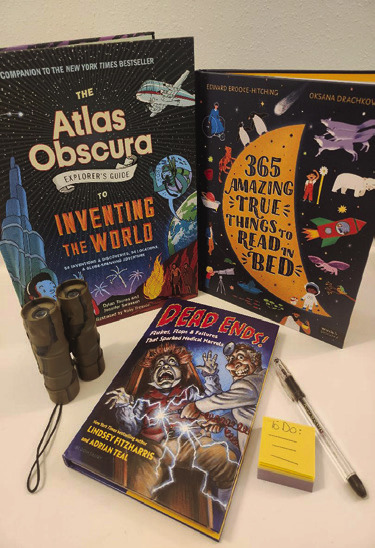c. 2025, various publishers, $19.99-$22.99, various page counts
Did you know….? Sometimes, that question can irritate you a lot. No, you didn’t know — but though you’re really, absolutely not a dummy, you might feel like one for a minute. You might not know certain things, but you can learn them by reading these three great books … Aspiring young scientists, doctors and nurses are going to love what they find in “ Dead Ends! Flukes, Flops & Failures That Sparked Medical Marvels” by Lindsey Fitzharris and Adrian Teal (Bloomsbury, $19.99).
Not really so long ago, physicians thought that potions and poultices were dandy cures for pretty much whatever ailed a person. They drained blood to fix an illness, people ate whatever they liked without a care, alcohol was used to heal wounds (which actually worked sometimes), and early dentists thought “tooth worms” were the cause of toothache. They were wrong — but they were on the right track! This book works for kids ages 8-12 because it’s slightly gross but wholly informative and it’ll have them wanting more history books just like it. (Out Tuesday, Oct. 14).
The kid who loves to sneak a book under the covers with them won’t mind an early bedtime when they have “365 Amazing True Things to Read in Bed” by Edward Brooke-Hitching and Oksana Drachkovska (Quarto, $22.99).
Things your 8-to-12-year-old will like best: This book is full of brief facts about animals, history, culture and more. What they read is true, so they can share the fun with others. This book is easy to browse and kids can dip in anywhere — which is great when falling asleep without a bookmark.
Things you’ll love about this book: See above, plus your child will be learning about new things but without the pressure.
And finally, for the adventurous 9-to-14-yearold who also loves to tinker, “The Atlas Obscura Explorer’s Guide to Inventing the World” by Dylan Thuras and Jennifer Swanson, illustrated by Ruby Fresson (Workman, $19.99) will open their eyes to science, history and innovation.
For a kid, this book might be a little like a trip around the world, but without leaving home. Each two-page mini-chapter begins with an everyday idea, things like steel or writing or video games. Kids get an overview of how those things were invented, a fun bit of time-travel advice in case they decide to take a trip back in time, and latitude and longitude for real global locations so your child’s GPS and their imagination can both get a work-out. In the back of the book, there’s even more information that may create a well-informed armchair traveler or a kid with a new appreciation for the world and its wonders.
If these books don’t quite fit what your curious kid could love to read, then head to your favorite bookstore or library and ask for help. The staff there will know what you need. Meantime, you can read the above books with your older elementary-schooler, tween or preteen, or you can just sneak them in the house for yourself.
And then you’ll know, too.
— The Bookworm Sez

